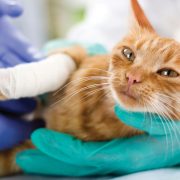Experimental infection of domestic dogs and cats with SARS-CoV-2: pathogenesis, transmission, and response to reexposure in cats
Experimental infection of domestic dogs and cats with SARS-CoV-2: pathogenesis, transmission, and response to reexposure in cats
Published 25 November 2020
Bosco-Lauth, A.M. et al. (2020) Experimental infection of domestic dogs and cats with SARS-CoV-2: Pathogenesis, transmission, and response to reexposure in cats. Proceedings of the National Academy of Sciences, 117 (42), pp. 26382-26388. https://doi.org/10.1073/pnas.2013102117
This paper reports on another small experimental study looking at susceptibility to infection with SARS-CoV-2 in dogs and cats. The study includes 3 small groups of animals.
In group 1, three cats were inoculated with virus and oro-pharyngeal swabs were collected on days 1–5, 7, 10, and 14 post infection (DPI), nasal flushes were performed on 1, 3, 5, 7, 10, and 14 DPI and blood was collected prior to inoculation and on 7, 14, 21, 28, 35, and 42 DPI. These cats were also reinoculated on day 42 from the initial infection. Oronasal sample collection was performed 1, 3, 5, 7, 10, and 14 days after reinoculation (days 29, 31, 33, 35, 38, and 42 post initial inoculation), at which time cats were euthanized and tissues collected for histopathology.
In group 2, two out of four cats were inoculated with SARS-CoV-2 and forty-eight hours post infection, two naive cats were introduced into the room with the infected cats and sampled on the same schedule as for group 1. The two directly challenged cats were euthanized on 5 DPI and tissues were collected for virus isolation and histopathology. The remaining two cats were euthanized at 30 DPI and necropsied.
Group 3 consisted of three dogs. Dogs were sampled at the same frequency and using the same methods as cats in Group 1 for 42 DPI. Dogs were not rechallenged.
The authors report that neither species developed clinical disease during this study. All directly inoculated cats shed virus for up to 5 days, the in-contact cats shed infectious virus orally by 24 hour post exposure, and shedding was prolonged with a peak occurring at 7 days. Viral shedding was not detected from any of the dogs at any point post infection or in cats following rechallenge.
All cats developed neutralizing antibodies as early as 7 DPI with titres of at least 1:2,560 by 14 DPI and either maintained or increased in titre between 28 and 42 DPI. Dogs developed neutralizing antibodies by 14 DPI and peaked at 21 DPI with titres between 1:40 and 1:80.
The authors conclude that cats are highly susceptible to infection, with a prolonged period of oral and nasal viral shedding that is not accompanied by clinical signs and are capable of direct contact transmission to other cats. Conversely, they found that dogs do not shed virus following infection but do seroconvert and mount an antiviral neutralizing antibody response.
This paper confirms the finding of other studies showing that both dogs and cats can be infected with SARS-CoV-2 under experimental conditions, that infected cats are able to pass on the infection and that both species seroconvert. However, these studies do not give any information about the likelihood of animals becoming infected or transmitting infection under non-experimental conditions, where the viral load is likely to be less.



Leave a Reply
Want to join the discussion?Feel free to contribute!